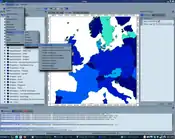 Human geographers use geographic information technology such as that pictured above in order to study important trends. |
What is human geography? Human geography, a subfield of geography, is concerned with the interactions of humans and the environment. It seeks to explain the demographic trends, economic attributes, and political configuration of regions by considering both the physical and the cultural landscape. It is thus distinct from physical geography, which focuses exclusively on natural features.
This textbook aims to provide a simple, no-fear introduction to the discipline, presenting its evolution and explaining its major concepts while remaining free of jargon. It is aimed at the general reader and thus does not follow the AP® curriculum of the subject of the same name. The help of educators and students alike is requested. |
Preface - Human Geography as a Discipline
Important figures and theories in the field of human geography; development and evolution of human geography; techniques employed by geographers |
.jpg.webp) | |
Chapter 1 - Methods and Challenges in Mapmaking
Overview of the history of cartography; how to properly read maps; advantages and disadvantages of competing projections of the Earth; impact of technology |
||
Chapter 2 - Studying Human Populations
Modern and historical demographic change in human societies; statistical models of development; epidemiology |
 | |
Chapter 3 - How People, Goods, and Ideas Spread
Introduction to cultural diffusion; mechanisms and types of cultural diffusion; migration and its effects |
||
Chapter 4 - The Distribution of the Languages of the Earth
Evolution of major languages; language families; language as a source of conflict and/or unity; language policy; pidgin and creole languages; impact of geography |
||
Chapter 5 - Major Belief Systems and Religions
The geographic distribution of beliefs systems and their adherents; universalizing and ethnic religions; religious conflict |
||
Chapter 6 - How Is Our World Organized Spatially?
The political structure of Earth; types of states; development of nation-states; regionalization and globalization; supranationalism and internationalism in the modern world |